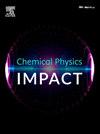蒙脱土/铁酸铜纳米复合材料光催化降解酸性蓝113染料:表征、优化及毒性评价
IF 4.3
Q2 CHEMISTRY, PHYSICAL
引用次数: 0
摘要
将尖晶石铁氧体铜(CuFe2O4)纳米颗粒负载于蒙脱土(MMT)上制备了MMT/CuFe2O4纳米复合材料,并在紫外和可见光存在下作为脱除酸性蓝113染料(AB113)的催化剂。采用响应面法(RSM)对所考虑的参数进行优化,最高效率为99.2%。捕集实验证实了在研究过程中产生了超氧化物(•O2-)自由基、羟基(•OH)、空穴(h+)和电子(e-)。在连续5个反应周期后,染料降解效率仅下降了6%。在MMT-CuFe2O4/Visible体系中,Cl-、NO3-、HCO3-和SO42-等阴离子明显阻碍AB113的降解。捕集实验表明,催化体系中的主要物质为•OH。通过在水蚤存在下进行实验来评估处理后溶液的毒性,毒性得到了明显的降低。我们的结果也代表了在紫外线和可见光存在下降解染料的近似相似的结果。结果表明,随着辐照时间从10 min延长至120 min,纳米复合材料的BOD5/COD (5 d生物需氧量/化学需氧量)和BOD5/TOC(总有机碳)比值分别从0.191提高到0.764和0.641提高到1.47。CuFe₂O₄和MMT在纳米复合材料中的协同作用通过生成活性氧增强了对酸性蓝113染料的光催化降解。在光照射下导致染料有效分解和矿化。本文章由计算机程序翻译,如有差异,请以英文原文为准。

Photocatalytic degradation of Acid blue 113 dye by montmorillonite/copper ferrite nanocomposite: Characterization, optimization, and toxicity assessment
The MMT/CuFe2O4 nanocomposite, prepared based on loading spinel ferrite copper (CuFe2O4) nanoparticles onto montmorillonite (MMT), was selected as a catalyst for removing acid blue 113 dye (AB113) in the system operated in the presence of UV and visible light. Response Surface Methodology (RSM) served as the tool for optimizing the considered parameters, and maximum efficiency of 99.2 % was obtained. Generating superoxide (•O2-) radical, hydroxyls (•OH), holes (h+), and electrons (e-) during the studied process was confirmed based on trapping experiments. The dye degradation efficiency, after the five consecutive reaction cycles, had only a low decrease (<6 %). In the MMT-CuFe2O4/Visible system, the degradation of AB113 was significantly impeded by anions like Cl-, NO3-, HCO3-, and SO42-. The primary species in the catalytic system, as revealed by trapping experiments, is •OH. By conducting the experiments in the presence of Daphnia Magna for assessing the toxicity of the treated solution, a detectable reduction in the toxicity was achieved. Our results were also representative of approximately similar results for degrading dye in the presence of both UV and visible lights. The results illustrated that the BOD5/COD (biological oxygen demand over 5 days/chemical oxygen demand) and BOD5/TOC (Total Organic Carbon) ratios were enhanced from 0.191 to 0.764 and 0.641 to 1.47, respectively, as the irradiation period was prolonged from 10 to 120 min. The synergistic effect of CuFe₂O₄ and MMT in the nanocomposite enhances the photocatalytic degradation of Acid Blue 113 dye by generating reactive oxygen species, leading to effective dye breakdown and mineralization under light irradiation.
求助全文
通过发布文献求助,成功后即可免费获取论文全文。
去求助
来源期刊

Chemical Physics Impact
Materials Science-Materials Science (miscellaneous)
CiteScore
2.60
自引率
0.00%
发文量
65
审稿时长
46 days
 求助内容:
求助内容: 应助结果提醒方式:
应助结果提醒方式:


